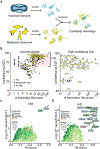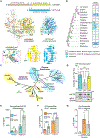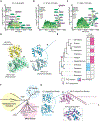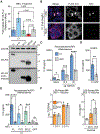Structural homology screens reveal host-derived poxvirus protein families impacting inflammasome activity
- PMID: 37494187
- PMCID: PMC10715236
- DOI: 10.1016/j.celrep.2023.112878
Structural homology screens reveal host-derived poxvirus protein families impacting inflammasome activity
Abstract
Viruses acquire host genes via horizontal transfer and can express them to manipulate host biology during infections. Some homologs retain sequence identity, but evolutionary divergence can obscure host origins. We use structural modeling to compare vaccinia virus proteins with metazoan proteomes. We identify vaccinia A47L as a homolog of gasdermins, the executioners of pyroptosis. An X-ray crystal structure of A47 confirms this homology, and cell-based assays reveal that A47 interferes with caspase function. We also identify vaccinia C1L as the product of a cryptic gene fusion event coupling a Bcl-2-related fold with a pyrin domain. C1 associates with components of the inflammasome, a cytosolic innate immune sensor involved in pyroptosis, yet paradoxically enhances inflammasome activity, suggesting differential modulation during infections. Our findings demonstrate the increasing power of structural homology screens to reveal proteins with unique combinations of domains that viruses capture from host genes and combine in unique ways.
Keywords: AlphaFold; CP: Immunology; CP: Microbiology; divergence; evolution; gasdermin; homology; inflammasome; poxvirus; pyroptosis; vaccinia; virus.
Copyright © 2023 The Authors. Published by Elsevier Inc. All rights reserved.
Conflict of interest statement
Declaration of interests The authors declare no competing interests.
Figures




Update of
-
Structural homology screens reveal poxvirus-encoded proteins impacting inflammasome-mediated defenses.bioRxiv [Preprint]. 2023 Apr 3:2023.02.26.529821. doi: 10.1101/2023.02.26.529821. bioRxiv. 2023. Update in: Cell Rep. 2023 Aug 29;42(8):112878. doi: 10.1016/j.celrep.2023.112878. PMID: 36909515 Free PMC article. Updated. Preprint.
Similar articles
-
Structural homology screens reveal poxvirus-encoded proteins impacting inflammasome-mediated defenses.bioRxiv [Preprint]. 2023 Apr 3:2023.02.26.529821. doi: 10.1101/2023.02.26.529821. bioRxiv. 2023. Update in: Cell Rep. 2023 Aug 29;42(8):112878. doi: 10.1016/j.celrep.2023.112878. PMID: 36909515 Free PMC article. Updated. Preprint.
-
A poxvirus Bcl-2-like gene family involved in regulation of host immune response: sequence similarity and evolutionary history.Virol J. 2010 Mar 15;7:59. doi: 10.1186/1743-422X-7-59. Virol J. 2010. PMID: 20230632 Free PMC article.
-
A life LINE for large viruses.Elife. 2022 Oct 25;11:e83488. doi: 10.7554/eLife.83488. Elife. 2022. PMID: 36282171 Free PMC article.
-
Pyroptosis, inflammasome, and gasdermins in tumor immunity.Innate Immun. 2023 Jan;29(1-2):3-13. doi: 10.1177/17534259221143216. Epub 2023 Jan 11. Innate Immun. 2023. PMID: 36632024 Free PMC article. Review.
-
Vaccinia and other poxvirus expression vectors.Curr Opin Biotechnol. 1992 Oct;3(5):518-22. doi: 10.1016/0958-1669(92)90080-3. Curr Opin Biotechnol. 1992. PMID: 1368937 Review.
Cited by
-
Molecular mimicry as a mechanism of viral immune evasion and autoimmunity.Nat Commun. 2024 Oct 30;15(1):9403. doi: 10.1038/s41467-024-53658-8. Nat Commun. 2024. PMID: 39477943 Free PMC article.
-
Monkeypox virus infection of human astrocytes causes gasdermin B cleavage and pyroptosis.Proc Natl Acad Sci U S A. 2024 Feb 20;121(8):e2315653121. doi: 10.1073/pnas.2315653121. Epub 2024 Feb 12. Proc Natl Acad Sci U S A. 2024. PMID: 38346199 Free PMC article.
-
The monkeypox virus-host interplays.Cell Insight. 2024 Jul 14;3(5):100185. doi: 10.1016/j.cellin.2024.100185. eCollection 2024 Oct. Cell Insight. 2024. PMID: 39144256 Free PMC article. Review.
-
The immune modules conserved across the tree of life: Towards a definition of ancestral immunity.PLoS Biol. 2024 Jul 15;22(7):e3002717. doi: 10.1371/journal.pbio.3002717. eCollection 2024 Jul. PLoS Biol. 2024. PMID: 39008452 Free PMC article.
-
Evolutionary insights and functional diversity of gasdermin family proteins and homologs in microorganisms.Front Immunol. 2024 Mar 20;15:1371611. doi: 10.3389/fimmu.2024.1371611. eCollection 2024. Front Immunol. 2024. PMID: 38571940 Free PMC article. Review.
References
Publication types
MeSH terms
Substances
Grants and funding
LinkOut - more resources
Full Text Sources
Research Materials
Miscellaneous

